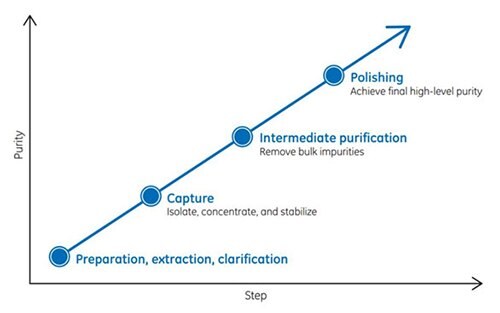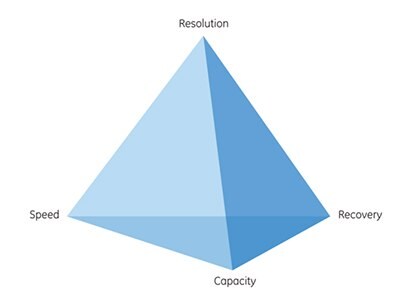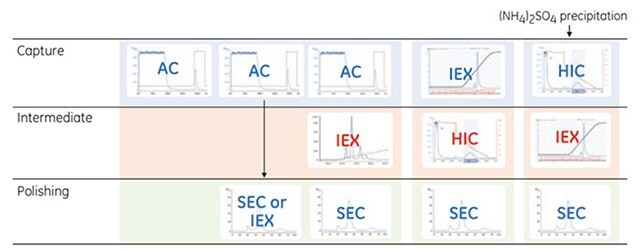Affinity Chromatography in a Purification Strategy (CIPP)
AC separates proteins on the basis of a reversible interaction between a protein (or group of proteins) and a specific ligand coupled to a chromatography matrix. With such high selectivity and hence high resolution for the protein(s) of interest, purification levels in the order of several thousand-fold with high recovery of active material are achievable. Samples are concentrated during binding and the target protein(s) is collected in a purified, concentrated form. AC can therefore offer immense time-saving over less selective multistep procedures.
In many cases, the high level of purity achieved in AC requires, at most, only a second step on a SEC column to remove unwanted small molecules, such as salts or aggregates.
For an even higher degree of purity, or when there is no suitable ligand for affinity purification, an efficient multistep process can be developed using the purification strategy of capture, intermediate purification, and polishing (CIPP), shown in Figure 9.1.
CIPP is used in both the pharmaceutical industry and in the research laboratory to ensure faster method development, a shorter time to pure product and good economy. AC can be used, in combination with other chromatography techniques, as an effective capture or intermediate step in a CIPP strategy.
This chapter gives a brief overview of the approach recommended for any multistep protein purification. The Strategies for Protein Purification Handbook, from Cytiva is highly recommended as a guide to planning efficient and effective protein purification strategies and for the selection of the correct medium for each step and scale of purification.

Figure 9.1. Preparation and CIPP.
Applying CIPP
Imagine the purification has three phases: Capture, Intermediate Purification, and Polishing.
Assign a specific objective to each step within the purification process.
The issues associated with a particular purification step will depend greatly upon the properties of the starting material. Thus, the objective of a purification step will vary according to its position in the process.
In the capture phase, the objectives are to isolate, concentrate, and stabilize the target product. The product should be concentrated and transferred to an environment that will conserve potency/activity.
During the intermediate purification phase, the objectives are to remove most of the bulk impurities, such as other proteins and nucleic acids, endotoxins, and viruses.
In the polishing phase, most impurities have already been removed. The objective is to achieve final purity by removing any remaining trace impurities or closely related substances.
The optimal selection and combination of purification techniques for Capture, Intermediate Purification, and Polishing is crucial for an efficient purification.
CIPP does not mean that there must always be three purification steps. For example, capture and intermediate purification might be achievable in a single step, as might intermediate purification and polishing. Similarly, purity demands can be so low that a rapid capture step is sufficient to achieve the desired result. For purification of therapeutic proteins, a fourth or fifth purification step might be required to fulfill the highest purity and safety demands. The number of steps used will always depend upon the purity requirements and intended use of the protein.
Selection and combination of purification techniques
Proteins are purified using purification techniques that separate according to differences in specific properties, as shown in Table 9.1.
There are four important performance parameters to consider when planning each purification step: resolution, capacity, speed, and recovery. Optimization of any one of these four parameters can be achieved only at the expense of the others, and each purification step will be a compromise (Figure 9.2). The importance of each parameter will vary depending on whether a purification step is used for capture, intermediate purification, or polishing. Purification methods should be selected and optimized to meet the objectives for each purification step.

Figure 9.2. Key performance parameters for protein purification. Each purification step should be optimized for one or two of the parameters.
Capacity, in the simple model shown, refers to the amount of target protein loaded during purification. In some cases the amount of sample that can be loaded will be limited by volume (as in SEC) or by large amounts of contaminants rather than the amount of the target protein.
Speed is most important at the beginning of purification where contaminant such as proteases must be removed as quickly as possible.
Recovery becomes increasingly important as the purification proceeds because of the increased value of the purified product. Recovery is influenced by destructive processes in the sample and by unfavourable conditions on the column.
Resolution is achieved by the selectivity of the technique and the efficiency and selectivity of the chromatography matrix in producing narrow peaks. In general, resolution is most difficult to achieve in the final stages of purification when impurities and target protein are likely to have very similar properties.
Select a technique to meet the objectives for the purification step.
Choose logical combinations of purification techniques based on the main benefits of the technique and the condition of the sample at the beginning or end of each step.
A guide to the suitability of each purification technique for the stages in CIPP is shown in Table 9.2.
Minimize sample handling between purification steps by combining techniques to avoid the need for sample conditioning. The product should be eluted from the first column in conditions suitable for the start conditions of the next column (Table 9.2).
Ammonium sulfate, often used for sample clarification and concentration (Appendix 1, Characteristics of Ni Sepharose, Ni Sepharose excel, TALON Superflow, and uncharged IMAC Sepharose products), leaves the sample in a high salt environment. Consequently HIC, which requires high salt to enhance binding to the chromatography media, becomes the excellent choice as the capture step. The salt concentration and the total sample volume will be significantly reduced after elution from the HIC column. Dilution of the fractionated sample or rapid buffer exchange using a desalting column will prepare it for the next IEX or AC step.
SEC is a nonbinding technique unaffected by buffer conditions, but with limited volume capacity. SEC is well-suited for use after any of the concentrating techniques (IEX, HIC, AC) since the target protein will be eluted in a reduced volume and the components from the buffer will not affect the size exclusion process.
Selection of the final strategy will always depend upon specific sample properties and the required level of purification. Logical combinations of techniques are shown in Figure 9.3.

Figure 9.3. Examples of logical combinations of chromatography steps.
For any capture step, select the technique showing the most effective binding to the target protein while binding as few of the contaminants as possible, that is, the technique with the highest selectivity and/or capacity for the target protein.
A sample is purified using a combination of techniques and alternative selectivities. For example, in an IEX-HIC-SEC strategy, the capture step selects according to differences in charge (IEX), the intermediate purification step according to differences in hydrophobicity (HIC), and the final polishing step according to differences in size (SEC).
If nothing is known about the target protein, use IEX-HIC-SEC. This combination of techniques can be regarded as a standard protocol.
Consider the use of both AIEX and CIEX to give different selectivities within the same purification strategy.
Materials
References
To continue reading please sign in or create an account.
Don't Have An Account?